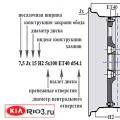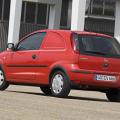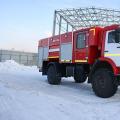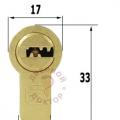The lock cylinder is the coded part of the cylinder lock, which provides security and moves the bolts. It is due to the fact that the larva is inserted into the body and has an elongated oblong shape that it is called in the open-air "larva". A sort of steel embryo.
In fact, in a professional environment, the cylinder lock mechanism is called a secrecy cylinder. Abbreviated as "CMS".
It is the correct name of this important part of the lock that we will use further in the text. But still, let's leave the "grub" in some places for better indexing;)
You can buy a cylinder or cylinder lock mechanism in a lock store. And to get a preliminary consultation - by the phone numbers listed above.
Quite often from the buyer we hear the phrase: "How can I replace the larva and what you need to know to pick it up"? The request has not been surprising for a long time: it is very difficult for an unprepared person to understand all the variety of secrecy cylinder mechanisms, their types, lengths and standards. In this article, we will consider the important parameters of the CMS and find out some of the nuances.
There are a lot of types of CMS. Let's start with the most common ones, which correspond to the European DIN standard (Europrofile) and which are used everywhere.

Here is what the buyer associates with the "door lock cylinder" in the first place:


Mechanisms of the Europrofile standard are produced in many countries: from China to Europe. The cost of a cylinder, depending on the model and manufacturer, can vary: from 150 rubles to 20,000 thousand rubles. The higher the quality and the more famous the brand of the mechanism, the more protective elements and innovative ideas are embodied in the lock cylinder, the higher its cost. For each model of a specific cylinder, you can write a separate material, for example, as a review article of the Slovenian CMS TITAN K56.
We will not stop here on any particular product, we will consider only the main parameters when choosing a cylinder.
Length and displacement of the lock cylinder
We are sure that you do not need to explain the calculation of the total cylinder length - it is the distance from one edge to the other. The required cylinder length is selected taking into account the thickness of the door leaf and on the basis of which cylinder lock you have chosen.
As we can see, the two parts of the cylinder are separated by a rotary cam. The cam width is always 10 mm.
The displacement of the cylinder is measured from the center of the mounting screw hole in both directions: outer and inner.
An equilateral cylinder is one in which both parts are equal in length. The versatile cylinder has different lengths for the same parts.
For example, below is a versatile English-type cylinder mechanism of Turkish production Kale Kilit with a total length of 71 mm. Often used on plastic doors.

Second example: a Chinese-made versatile cylinder mechanism with a total length of 90 mm. It is this size of the lock cylinder that is now popular on Chinese doors.

A cylinder of the correct length should not protrude much beyond the plane of the door leaf. If it is a wooden door, here the cylinder must be installed flush with the decorative strip or with the strip from the handle (up to 3 mm overhang is permissible). If an armor plate is installed on a cylinder lock, the length of the outer part of the cylinder will depend on the specific armor plate, on the method of its installation and on the specific door.
There are no fundamental requirements for the length of the inner part of the cylinder. But if, on the inside, the mechanism is also flush with the door trim or decorative strip, it will look aesthetically pleasing and harmonious.
Castle Larva with Pinwheel
For ease of use, the door lock cylinder can have a rotary pinch. It allows you to open and close the cylinder lock from the inside without a key. At the same time, the turntable has no "blind spots" - in any position, the native key will always open the lock.
Equilateral Chinese cylinder mechanism 60 mm in length, with a rotary turntable from the inside:

Versatile Italian movement 72 mm long, with a swivel handle from the inside (the enlarged inner part of the cylinder is designed for the thickness of the inner panel of the door):

Other Cylinder Security Standards
If the cylinders described above are suitable for some standards, and can be installed in any cylinder lock case, then the following security mechanisms considered have other dimensions and fit strictly individually for one specific lock (or for some models of the same manufacturer). For example, the cross-type cylinder mechanism of the Turkish company "KALE KILIT".

Suitable only for locks of this type (installation in locks of other Turkish manufacturers (for example, FAYN) is possible, or with a slight alteration, for locks of Chinese production (for example, 3M)).
And here is the domestic cross-key secrecy mechanism:

Suitable only for locks made in Kirov. And as you probably already understood, the Kirov movement cannot be inserted into the KALE KILIT case and vice versa.
For some domestic overhead locks, it is possible to purchase a cylinder separately. For example, the often breaking mechanism "FORT", which is suitable only for locks produced in the city of Petrozavodsk.

Locks of terrible quality, the mechanism of secrecy and the components of the lock are made mostly of silumin (a very fragile alloy), hence the frequent breakdowns and, of course, the availability of the opportunity to purchase a new cylinder! In the next photo, from left to right, you can see the cylinder mechanisms for the "Glazov" and "Iset" overhead locks.

Their problem is the same - soft materials and poor workmanship. Often these specific cylinders (there is no better quality cylinder to choose from) are ordered and manufactured in China.

If you need to replace the lock cylinder in Nizhny Novgorod - our service specialists are always at your service by phone + 7-987-110-30-43.
Beforehand, we will find out what will suit you, we will guide you on prices and, after agreement, we will send a master to you for a replacement.
The assortment of our company includes a huge selection of CMS. We sell both cheap Turkish and Chinese larvae and highly secret CMS from renowned European manufacturers. If, after reading the material, the castle larva still raises questions, we are always happy to advise you in the comments under this material.
The lock- this is the part of the cylinder lock that moves the bolt, and on which the lock secrecy depends. Professionals call the maggot the cylinder secrecy mechanism (CMS). Our clients often ask the question: "How can you change the larva, and what you need to know for this?" In this article, we will consider the main parameters of the CMS and consider some examples.
To correctly install the cylinder, you need to know the following parameters: the length of the entire cylinder, and the distance from the edges of the cylinder to the center of the mounting screw. On the diagram, these are the distances "A" and "V".
A cylinder in which both parts are equal in length is called equilateral.

If the lengths of the 2 parts are different, then such a cylinder is called versatile.

Its length is 90 mm. This size of a versatile larva is often found in the doors of an Italian company. UNION, as well as in the doors of the Chinese-made Forpost, Master-Lock, etc.
The parts of the cylinder are divided by the so-called rotary cam... Its width is 10 mm... Cylinder displacement is measured from the center of the rotary cam. If the cylinder is selected correctly in length, it should not protrude much beyond the door leaf, decorative strips or door hardware. If an armored pad is installed on the cylinder lock, the length of the protruding part of the cylinder will depend on the type of armored pad to be installed, the installation method and on the specific door. There are no special requirements for the length of the inner part of the cylinder.
The lock cylinder is a code part of the mechanism, which ensures the secrecy of the structure and moves the bolts. Because the cylinder is inserted into the body and looks like an oblong detail, in the common people it was dubbed a "larva".
Many buyers are wondering how to choose a cylinder for a lock, what must be taken into account and, in general, what types of this mechanism exist. Let's try to understand all the structural variety of "larvae", having considered the basic standards, parameters and nuances.
Before choosing a cylinder, you should know that there are a lot of types of "larvae". Let's designate the most common models that meet the European DIN standards ("Europrofile"). In addition, their widespread use has supplanted other similar types of cylinders.
Certified mechanisms are produced in many countries: from Japan to Portugal. The price of the "larva" directly depends on the design features and the manufacturer (from 100 to 30,000 rubles). The more serious the brand and the better the mechanism, the higher its cost. Here you can add some innovative ideas, original material, etc.
In order for a common man to figure out how to choose a cylinder, it is necessary to clarify the main parameters responsible for the operation of the mechanism.
Length and offset
The first parameter is length: the distance from one end of the cylinder to the other. Dimensions vary depending on the thickness of the door leaf and lock.
The next is the displacement of the "larva". Typically, the cylinder is separated by a rotary cam, which is offset to one side, dividing the mechanism into an outer and an inner part. If the cam is exactly in the middle, then the cylinder is considered equilateral.
Dimensions (edit)
For example, the dimensions of the cylinders for Turkish-made locks of the English type are as follows: 71 mm with an offset of 40 and 31 mm, respectively. This design is used mainly in plastic products: office and verandas, gazebos, etc.

The most common cylinder sizes for locks have Chinese mechanisms with a total length of 90 mm. This size is widely used on the entrance and interior doors made in China, which literally flooded our market.

When choosing a lock for a cylinder, it is important to take into account that the entire structure does not protrude beyond the plane of the door leaf, both from one side and the other. If the door is made of wood, then the "larva" should be flush with the decorative strip. The maximum allowable "larva" peeking out is 3 mm: anything that goes beyond these limits can be easily used by burglars. In the event that the lock is equipped with an armored plate, the length of the outer part of the mechanism will already depend on the specific dimensions of this plate and the door itself.
Pinwheel Lock Cylinder
Sometimes the cylinder can be equipped with a rotating turntable for convenience. It allows you to easily open and close the mechanism without a key. It is worth noting that the spinner has no "dead" points, therefore, in any position of the slider, the native key on the other side will always open the lock.

The main model range is presented in our market by Chinese manufacturers (60 mm movement) and more expensive Italian models with a rotary handle (72 mm).
Other Cylinder Standards
If the above models are suitable for almost any lock and you can safely buy them for standard doors, then the following mechanisms have specific dimensions and may be suitable only for a specific design or one manufacturer. Therefore, always pay attention to the specification of the "larva" before choosing a cylinder.

The most striking example of originality is the products of the Turkish company Kale Kilit. Their locks are distinguished by increased reliability, but are suitable only for mechanisms of the same type. Some skilled craftsmen can remake a Chinese lock to fit a Kale Kilit cylinder, while receiving a significantly reduced cost of the movement.
Domestic castles
Domestic producers are not lagging behind imported ones, although prices are sometimes higher than Turkish ones with a similar quality. Kirov cylinders with a cross key have proven themselves perfectly, and just like in the previous case, the domestic mechanism cannot be inserted into an imported case and vice versa.
Before choosing a cylinder, you should take into account that you can purchase a "larva" separately for some domestic mechanisms. A striking example is the often breaking mechanism "Fort", which is produced in Petrozavodsk. The apparent cheapness of the design has its undeniable disadvantages: the secrecy mechanisms, together with the main cylinder units, are made of a waste and fragile silumin alloy, hence the frequency of breakdowns, and at the same time the opportunity to buy a new cylinder assembly (good

Other domestic mechanisms such as Glazov and Iset suffer from similar problems: too fragile materials, coupled with poor product quality. But, unlike Kirov locks, specific cylinders are not sold separately by factories, so you have to order them in China.
Secret
In most cases, the cylinder is the weakest link in the locking mechanism. Intruders break them, drill them out, or simply pick up a master key, so the reliable secret of the lock is the main obstacle to this kind of encroachment. You need to choose a mechanism wisely and there is no need to save on the cylinder. Let's take a look at the main hacking methods and how to avoid them.
Pick a pick. A sensible manufacturer always equips its mechanisms with false slots, significantly complicating the key selection process.
Bumping... The method is based on brute force: any suitable wrench is inserted into the hole, then it is hit with a hammer. The pins and pins separate and the mechanism is useless. In this case, the high-strength material of the cylinder and the non-standard hole help.
Drilling. The only protection against this kind of burglary is reinforced alloys and metals that cannot be drilled.
Knocking out. The main protection is again the materials from which the cylinder is made. The best option is tungsten carbide elements that do not bend, do not crumble and reliably protect against this type of burglary.
Summarizing
Choosing a cylinder for the lock, in no case should you save. Good materials are not cheap, so a junk Chinese design for 300-500 rubles will not save you even from an amateur fraudster. It is also worth considering factors such as the durability of the mechanism, design and ease of use. If you have children in your family whom you trust with the key, then the lock should not be an obstacle to quickly get home. Be sure to consider this point. Sometimes, in pursuit of anti-burglary mechanisms, people forget about such obvious things as ease of use, and suffer with inconvenient keys and tricky locks. Therefore, this factor must also be taken into account.
The reasons for changing the lock cylinder can be different. It often happens that keys are lost, or the core itself wedges and jams. Many are faced with the need to replace the old castle larva with a new, more modern and protected one. In any case, if you have already decided on the model, then in order to choose a suitable secret, you should also decide on the size. Choosing the right size is not difficult, it is enough to understand what and how to measure.
The main criteria for the dimension of cylinders
DIN is considered to be the modern and most widespread standard of cylinder secrecy mechanisms (CMS). This standard was developed by the German Bureau for Standardization and assumes the passage of a secret through the lock, while the shape of the cylinder, its width and height, have become universal, and can be interchangeable and compatible with locks and accessories from different manufacturers.

Thus, the main criteria for choosing a cylinder are its length and symmetry. The total length of the cylinder directly depends on the thickness of the door, the presence of casing, armor plates or protective fittings. It is important to understand that the cylinder should not be recessed into the door body, or protrude beyond it, especially from the outside of the door. With the correct size, the outer side of the cylinder should be flush with the door leaf, otherwise, intruders can pull out the cylinder by grasping this protrusion. Minor indents are allowed, no more than two millimeters from the outside. This is a compromise option if there are no cylinders of the required size in the model range. This often happens when you decide to replace an old Chinese core with a new one from another manufacturer. For some manufacturers, the total length of the cylinder can be 0.5 - 1 mm more, these are the features of production.

The total length of the cylinder, in turn, is divided into two components - the inner dimension and the outer. In symmetrical cylinders, these two values are equal, which means that the lock is installed inside the door in the middle, but if the lock is displaced, then the cylinder for it is called asymmetric.

The figure shows an example of a symmetrical core where sides A and B are equal. The symmetry of the core is measured from the edge to the center of the fastening screw hole. Some manufacturers specify dimensions based on the standard tongue thickness, usually 10 mm.

In this picture, side B is larger than A. This is an example of an asymmetrical cylinder, with the same overall length, most manufacturers have many asymmetric models.
Determining the size of the cylinder
The easiest way to figure out what size and symmetry you need is to take out the old core and measure the total length with a ruler, the length of the inside to the center of the hole, and the outside length from the center. Most core models have no distinction between inside and outside, but there are exceptions. For example, the cylinder has a hardened body on the outside, therefore, when purchasing such a cylinder, you should choose the symmetry taking into account this feature.

On our website, the dimensions of the cylinders are written in the form of 100 (50x50), where 100 is the total length in millimeters, and in brackets is the outer and inner, respectively. For asymmetric cylinders, the size will be 100 (40x60), where the outer side is 40 and the inner side is 60 millimeters. In cylinders with a turn signal, or with special options on one of the sides in the name of the product, the size will be written as 100 (50x50T), where the letter T denotes the toggle switch (turn signal) on the inside. For Abloy cylinders with the Hard option, the size is written as 103 (47Hx56), where 47H means that the outer part of the cylinder is 47mm and a hardened body (Hard) is installed on this side, additionally, the manufacturer marks it with a special sticker “Outside” on the outside.
There is another type of cylinders, the so-called key-half cylinders. They have only one size, while the second part of the cylinder has a standard size, usually 9 - 10 mm. Such cylinders are used when it is necessary to lock the door only from one side, and their dimensions are written in the form 41 (9.5x31), where 9.5 is the size of the “blind” part.

If you do not have an old cylinder, then the size is determined from the center of the hole on the lock bar to the edges of the door, taking into account the trim, the presence or absence of protective fittings. Craftsmen use a special tool for this, therefore, it is better to find out the size of the cylinder on a new door in production.
What if you decided to change the cylinder to a new one, but the required size was not found, or the manufacturer's dimensions differ by 0.5 - 1 mm. First of all, it is worth starting with whether you already have an armor plate, or are you planning to install it.
When the cover is already installed, it is usually placed with a small tolerance.

The difference between dimensions A and B in the figure shows the tolerance between the cylinder and the mortise plate, you can determine its size without disassembling the plate. Unscrew the fastening bolt of your old cylinder and push it all the way into the inside of the lining.

Dimension B should be added to the outer side, therefore, you can find out the maximum outer dimension of the cylinder.
If there is no armor plate, then depending on the type and method of installation, the size of the core may differ up or down from the size of your old cylinder or the thickness of the door.




